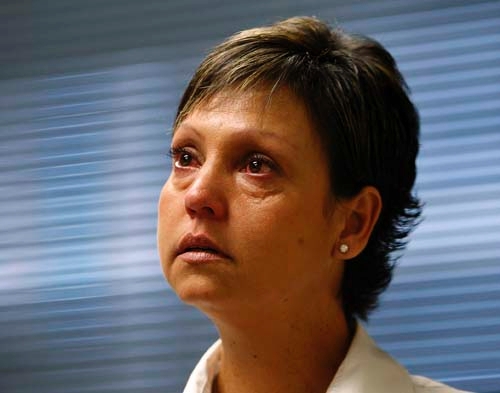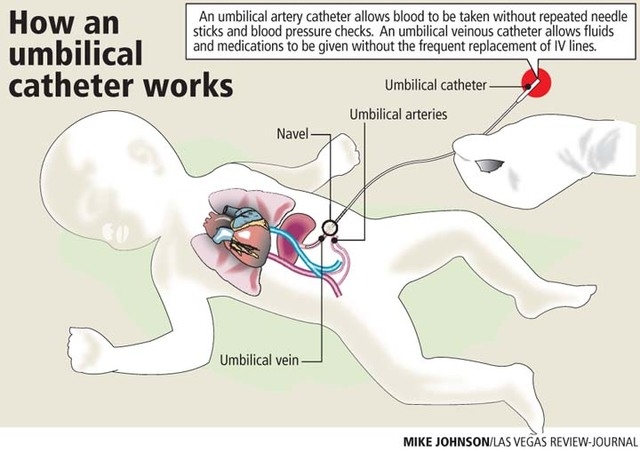Babies’ deaths haunt Sunrise nurses
The dark, puffy circles under her eyes make it look like boxing champ Manny Pacquiao has peppered her with left jabs.
"I'm so exhausted," Sharon Ochoa-Reyes said, pointing to the bags under her eyes and unable to stop tears from streaming down her face. "I can't sleep anymore. It's so hard to have people thinking I'm a monster, that I could hurt little babies."
It is midday Thursday as the 45-year-old mother of four, a registered nurse who has spent most of her professional life at Sunrise Children's Hospital caring for the tiniest of babies, sits in the office of her attorney, George Kelesis. Pictures of her former patients and her family lie on the desk in front of her.
"I still can't believe this nightmare continues," she said, wiping her eyes with a tissue with one hand as she picks up a photograph with the other. "Look at this child. I started caring for this baby at 23 weeks, and the family and I still stay in touch. I'm no angel of death. Look at my beautiful kids. I'm a caring nurse and loving wife and mother."
In early July, the public first began to learn about what Ochoa-Reyes calls her nightmare. It was then that Sunrise officials, in a statement with more questions than answers, said they had asked Las Vegas police to investigate 14 incidents of "disrupted catheters" that tracked back to February.
"We had been having problems with catheters breaking for months," Ochoa-Reyes said. "Even though nurses reported the product failures, the hospital administration basically paid no real attention to it until babies got hurt."
The July Sunrise press release, which noted that one child needed emergency surgery and another was in critical condition -- she later died and her death was ruled a homicide -- actually deepened the mystery of what happened at the hospital by its reference to "disrupted catheters."
No American medical safety expert contacted by the Review-Journal, including the head of the respected Pennsylvania-based Institute for Safe Medication Practices, had ever heard the term "disrupted catheters" used to describe problems with the equipment.
In the weeks that followed, Ochoa-Reyes and Jessica May Rice, two nurses who had worked in the Sunrise Neonatal Intensive Care Unit, had their licenses summarily suspended by the state nursing board after law enforcement authorities informed the regulatory agency that each nurse was a "person of interest" in an ongoing criminal investigation into "intentional patient harm." Sunrise officials fired them.
As criminologists speculated as to whether the pair of nurses could be angels of death -- nurses who say they kill patients out of mercy -- authorities refused to say what evidence connected the nurses to "intentional patient harm," a question that remains unanswered to this day.
Nurses' licenses reinstated
And then, in September, the mystery surrounding what happened at Sunrise took another turn.
The Nevada State Nursing Board, with a mission of protecting the public's health, safety and welfare, reinstated the licenses of the nurses.
Debra Scott, executive director of the board, said that based on subpoenaed records obtained from Sunrise about the problems with catheters at the health facility, "there is absolutely no evidence that these nurses did anything wrong. We need some proof and there isn't any."
Kelesis believes the hospital would have given the most damning evidence to the nursing board.
"They've blamed the nurses for problems they've long had, but there's nothing in the records to support it," he said.
Sunrise officials refuse to rehire the nurses.
The subpoenaed records, which were obtained by the Review-Journal, raised the question of whether product failure could have been behind the "disruptions" with catheters at Sunrise, something the hospital's own forensic expert admits he has not ruled out.
"They (Sunrise administrators) didn't ask me to test for product failures," said W. Don Bunn , a failure analysis expert for Oklahoma-based Sherry Laboratories who was hired by the Las Vegas hospital. "They only asked me to test to see if the catheters could have been cut. I would have had to do more tests to see if there could have been product failure."
Sunrise Vice President Dan Davidson said Friday that hospital officials enlisted the expertise of a forensics engineer "to examine the products. His report showed lines had been cut."
Davidson also said Friday that the hospital had been doing "product assessments" on catheter lines since early January and made changes to catheter lines "in an effort to isolate a potential product issue as the cause of the disruptions."
However, subpoenaed e-mails show that Sunrise officials were not talking to manufacturers about changing brands of catheter lines early in the year but about changing the filters, ports and IV tubing that a catheter line can attach to.
"What we changed was the filters that attach to the IV tubing that is well above the catheter lines," said Ochoa-Reyes. "They did not do any changes to the 26-gauge catheter lines. "
It wasn't until May 11, according to an e-mail found in the subpoenaed records, that a Sunrise official contacted manufacturer Becton Dickinson about "issues with our PICC lines breaking over the last couple of months."
That e-mail, sent by Neonatal Intensive Care Unit clinical practice coordinator Dana Lunde, was directed to Lynn Brown of Becton Dickinson.
"Could you please get back in contact with me so we can discuss our issues?" Lunde wrote.
The subpoenaed records do not include a reply from Brown. A Becton Dickinson official contacted by the Review-Journal said her company cannot share company e-mails with the media.
Bunn, whose test results on seven catheters were the only ones included in the subpoenaed records, said he was surprised that the hospital didn't want to know whether there had been a product failure. "That's what I'm usually asked to do," he said.
Davidson said the hospital found a new vendor for the hospital's catheter lines in May. He noted that there have been no occurrences of disruptions since the May "disruption."
"The hospital tries to make it look like the reasons problems stopped at the neonatal unit in May was because they let us go," said Ochoa-Reyes. "But the reason is they finally got new catheter lines after babies got hurt."
In August, the Food and Drug Administration issued a newsletter describing 46 adverse events with peripherally inserted central catheters, the kind that Sunrise said "disrupted" at the hospital 13 times.
One of those disruptions saw part of catheter migrate to a baby's heart, and a Sunrise surgeon had to retrieve it.
Becton Dickinson, Sunrise's supplier of that kind of catheter for years, led the list of manufacturers listed by the FDA with adverse event reports. More than half of the adverse events were caused either by catheter breaks, structural defects or fractures.
In August 2008, the FDA issued a similar newsletter describing 36 adverse events with umbilical catheters, the kind used on 2-month-old Miowne Obote, who died in the Sunrise Neonatal Intensive Care unit in July.
Twenty-five of the events involved Covidien, the manufacturer of Sunrise's product that goes under the trade name Kendall. Thirteen of the events involved device breakage or a defective device.
Simulated catheter cuts
Using a microscope with magnification, forensic expert Bunn said he took pictures of the seven broken catheters that Sunrise officials allowed him to photograph. He then took the pictures back to his lab and tried to simulate the cuts he saw in the photos on sample catheters.
On five sample catheters he was able to simulate cuts with scissors that Bunn said were "consistent" with what he saw in photographs.
On another sample in which he used a razor blade and tubing cutter, he was able to make cuts that were "consistent" with another photographed catheter.
For one catheter he was unable to simulate the cut.
Regardless of what he found in his tests, Bunn reiterated that he cannot rule out product failure.
"There's no way I could do that with what I did," he said.
What Bunn had to say infuriates Kathleen Murphy Jones, the attorney for 32-year-old Jessica Rice.
"It's outrageous that Sunrise didn't do a product-failure test the very first thing," she said. "Why put everybody through this -- the nurses, the community, parents of children at Sunrise -- until you know what you're talking about?"
A physician who works inside the Sunrise Neonatal Intensive Care Unit wondered the same thing.
"You would think," the doctor said, "that is something (a product-failure test) they'd do."
Surveyors with the Nevada State Health Division were under the impression that Bunn had done a product-failure test, even saying so in a written report done for the Centers for Medicare and Medicaid Services that absolved the hospital of fault for the series of catheter incidents.
"An outside forensic expert was also hired by the facility to determine the cause of the PICC line disruptions," the report reads.
State investigator Diane Allen, in an Oct. 22 memo to Richard Whitley, administrator of the state Department of Health and Human Services, noted that "the facility had hired a forensic expert to validate the UAC line (used on baby Obote) was in fact 'cut.' "
Allen also wrote in the memo: "According to the facility (Sunrise) they had been using the product (catheters) for 7-10 years and were concerned with the disruption of the catheters. The devices may break at insertion, or have fluid insertion under the skin."
To attorney Kelesis, it is clear what Sunrise has done with the nurses. "They were pointing the finger at them to reduce liability for a problem that they had had for a long time and done nothing about," he said.
Sunrise officials have never said what happened to the children involved in the other 12 incidents of disrupted catheters.
Sunrise's Davidson said Friday he cannot discuss many specifics about the investigation at the request of police.
Bill Cassell, police spokesman, said the department can't comment on an ongoing investigation.
State health investigators weren't the only ones drawing conclusions from Bunn's work.
Clark County Coroner Mike Murphy said last week that Bunn's determinations played a key role in his office's ruling that baby Obote's death was a homicide. In May, the coroner said, the child's catheter was "severed," leading to her death two months later.
Murphy said Bunn's work, coupled with what a Sunrise attending physician said and "other issues," worked into the conclusion of homicide.
Rice said that on the May evening that baby Obote's catheter was found broken Dr. Martin Blahnik told those who worked with the baby that attempts to resuscitate the baby might have broken the fragile catheter.
Attempts to reach Blahnik were unsuccessful.
In the hospital's incident report subpoenaed by the nursing board, it states, "Blahnik observed that umbilical line had snapped."
No hospital interview notes
Kelesis said it's hard to get a full picture of what happened because hospital officials refuse to turn over the material requested.
"I'm pretty sure that Sunrise didn't include all the records that were subpoenaed," Kelesis said.
The nursing board's director, Debra Scott, said she, too, was surprised by some of the answers that Sunrise officials gave in reply to the subpoena for records.
For instance, Sunrise officials said that "after a thorough and diligent search, no notes, memoranda, transcripts or records were taken during any employee interviews conducted by Sunrise Hospital in the course of its investigation of catheter ... 'disruption' at the hospital."
Rice and Ochoa-Reyes said notes were taken as they were interviewed by hospital officials.
"We always take notes at the nursing board when we do an investigation," Scott said.
Hospital officials also refused to show copies of all reports made to device manufacturers involving catheter failures since 2008, saying such information is "irrelevant."
"How can it be irrelevant to know what kind of problems the hospital was having with catheter lines?" Kelesis said.
Sunrise provided incident reports for only 10 of the 14 "disruptions." Of those, three involved Rice and four mentioned Ochoa-Reyes, either as witness to a problem or having had a patient with a problem. There is no mention of why all the incident reports that were subpoenaed weren't included.
Both Rice and Ochoa-Reyes were on duty at the hospital when the incident occurred that eventually led to baby Obote's death. But when an alarm went off showing that the child was in distress, another nurse rushed to the child first and a doctor and a nurse educator were called, subpoenaed documents show.
"I was doing some charting work nearby," said Rice, who had been assigned to the baby.
"I came over and did some compressions for a little bit, but the doctor and the nurse educator took over," Rice said.
Documents show Ochoa-Reyes did not work with the baby.
Nothing to hide
Both nurses now say they realize they were naive in dealing with authorities. Both agreed to police interviews and polygraphs because they said they had nothing to hide.
But in separate interviews with police, each said a detective ended up yelling that she enjoyed killing babies.
"I couldn't believe what I was hearing," Ochoa-Reyes said. "I told them over and over I would never do such a thing."
Rice said she listened to a police detective rant and rave about her being a baby killer for four hours.
Finally, she said, the detective told her to leave when she kept repeating that she would never hurt a child.
While the nurses are co-workers, they are not close friends.
"We don't go out together or anything," Rice said. "We don't even eat together. I know they were trying to make it look like we were close, but we aren't."
The loss of their jobs has hurt each nurse financially.
And they wonder if this experience has so tarnished their reputations that they'll ever be hired in the medical field again.
Rice has filed for bankruptcy and now lives in a small apartment with her sister. She is receiving unemployment benefits.
Ochoa-Reyes said she and her husband, a surgical technician, are trying to hold on.
Sunrise officials fought against her getting unemployment benefits, and so far she does not receive any. How they will continue to pay the mortgage on both her home and that of her mother is unclear.
"We've gone through all of our savings," Ochoa-Reyes said. "And one of our biggest problems now is that I got insurance for me and my kids through my job at Sunrise. Now only my husband has his through his job."
The union representing the nurses, Service Employees International Union 1107, has filed grievances over the nurses' firings, arguing wrongful terminations.
The women have tried to figure how Sunrise and the police connected them to the death of baby Obote. They concluded Rice was baby Obote's assigned nurse, and Ochoa-Reyes, a nurse specially trained in handling catheter lines, was working the night that baby Obote's catheter line broke.
"It makes absolutely no sense," Ochoa-Reyes moaned. "I've never hurt anybody. But I'm sure getting hurt now."
Contact reporter Paul Harasim at pharasim@reviewjournal.com or 702-387-2908.





























